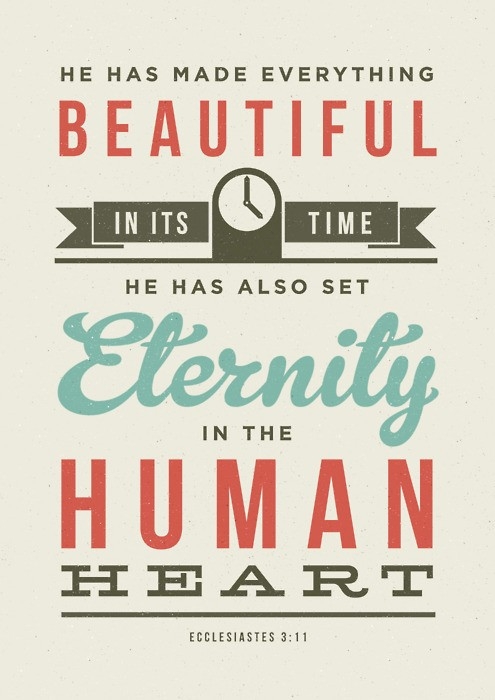
“He has made
everything beautiful in its time. Also, he has put eternity into man's heart,
yet so that he cannot find out what God has done from the beginning to the end”
(Ecc. 3:11).
The
human heart has a deep-seated longing to transcend our finite, earthly
existence and to know the eternal God. The God-shaped vacuum at the core of our
being demands to be filled. We have an itch for eternity that can only be
scratched by the Divine. As Augustine said, “God has made us for himself and
our hearts are restless until they rest in Him.”
The
phrase “eternity in their hearts” means God has placed a big question mark deep
in every man’s soul. This is proven by the fact that anthropological evidence
suggests that every culture has an innate sense of the eternal—that this world
is not all there is. The Egyptians erected the pyramids, Native Americans
labored over sacred burial mounds and the Romans built huge mausoleums. Why?
They each were in their own darkened way grappling to work out the eternal
longing imbedded in their heart. Their mythology told them that time was merely
a dress rehearsal for eternity.
Don
Richardson wrote a fascinating book entitled, Eternity in their Hearts based on Ecclesiastes 3:11. In this survey
he presents more than twenty-five examples of missionaries all over the world
who discovered cultures completely cut-off from Christianity. Yet all these
tribal groups which were detached from civilization worshipped some kind of
transcendent being. In an eerie way, these primitive people had deep longing
for God, even if their religious rituals were misguided.
For
example, Richardson tells about his experiences with the Sawi tribes of Dutch
New Guinea—the headhunters whom Richardson went to evangelize in the 1950s.
Though the bloodthirsty Sawi people prized war and violence, they also had a
sacred ritual for reconciling two warring tribes. The chief’s own son would be
offered to the other tribe as a “peace child.” Richardson saw this ritual as a
parable of the Gospel, in which the Chief of all chieftains made peace with the
lost tribe of humanity by offering up His only Son. Richardson’s thesis
contended that, “Every human being has eternity in their heart and that winning
people to Christ is a matter of discovering what piece or part of eternity they
are familiar with and then helping them connect the dots to Christ.”[1]
According
to Solomon, humanity is caught between time and eternity, thus the best way to
spend our time is to live it in light of eternity. As finite creatures we cannot understand the
times and the seasons, the beginning from the end, until we have a personal
relationship with the Creator of time. The great mystery is that God
accomplishes His purposes in time, but it will not be until we enter eternity
that we will begin to comprehend His total plan. As Vance Havner has said, “The things we
don’t understand about life—God puts a note on them that says, ‘I’ll explain
later.’”
The
New Testament counterpart to Ecclesiastes 3:11, is Romans 8:28, “For we know
that God works all things together for good to those that love Him and are
called according to his purpose.” In other words, from the Divine perspective
there is no ugliness in the events of our lives, only light and dark
brushstrokes from the paintbrush of the Master.
I
once heard Dr. Erwin Lutzer, of Chicago’s historic Moody Bible Church, tell the
story about a trip that he took to an art museum. He said that as he was looking at a painting
by the master artist Rembrandt he noticed an ant crawling across the surface of
the canvas. He thought to himself, “How
did that ant get up there on the painting?” Then he said, “There was no way the
ant had any idea that he was walking on a priceless piece of art, to him it
just looked like a muddled splotches of brown and grey.” Lutzer commented that that’s what life is
like when you have a narrow perspective.
We are like the ant unknowingly walking across a masterpiece. However,
God’s sees the total picture. When we see a muddled composition it’s because we
are too close to put things into perspective. Eternity is the only correct
vantage point to judge time.
-DM
No comments:
Post a Comment